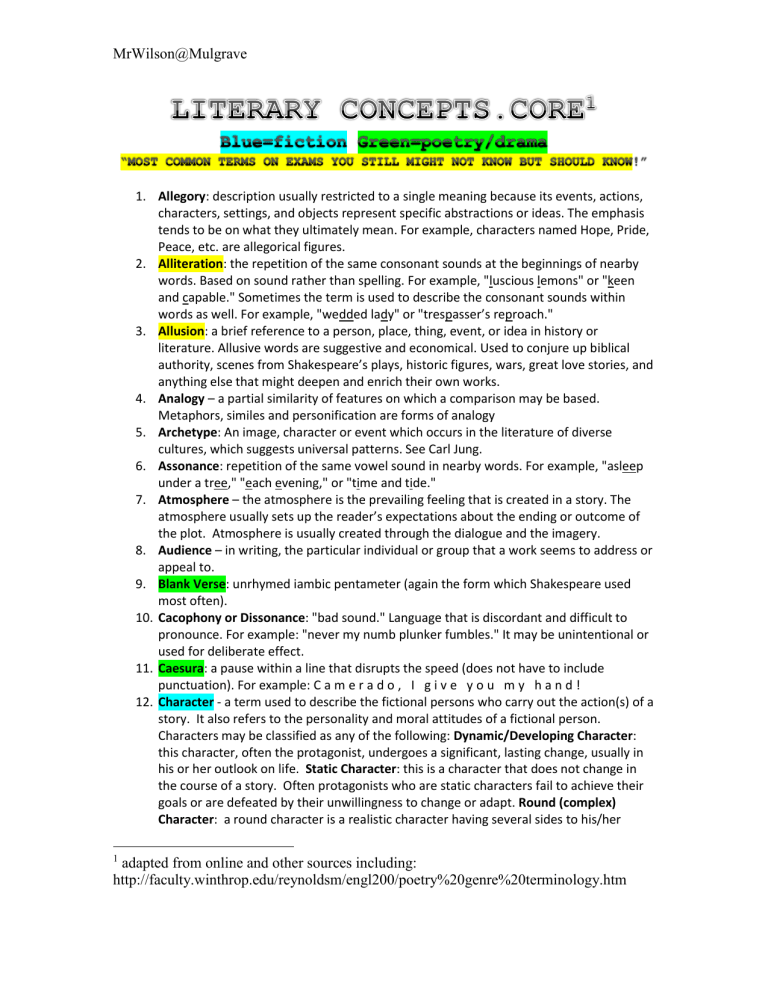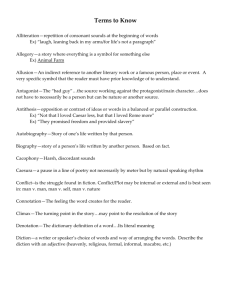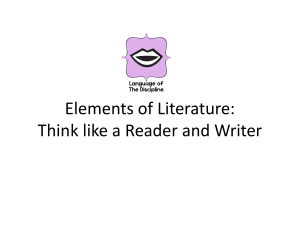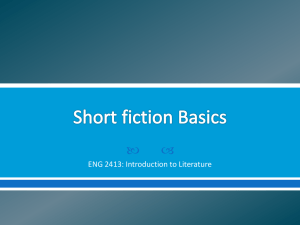POETRY Genre Terminology

MrWilson@Mulgrave
1.
Allegory: description usually restricted to a single meaning because its events, actions, characters, settings, and objects represent specific abstractions or ideas. The emphasis tends to be on what they ultimately mean. For example, characters named Hope, Pride,
Peace, etc. are allegorical figures.
2.
Alliteration: the repetition of the same consonant sounds at the beginnings of nearby words. Based on sound rather than spelling. For example, "luscious lemons" or "keen and capable." Sometimes the term is used to describe the consonant sounds within words as well. For example, "wedded lady" or "trespasser’s reproach."
3.
Allusion: a brief reference to a person, place, thing, event, or idea in history or literature. Allusive words are suggestive and economical. Used to conjure up biblical authority, scenes from Shakespeare’s plays, historic figures, wars, great love stories, and anything else that might deepen and enrich their own works.
4.
Analogy – a partial similarity of features on which a comparison may be based.
Metaphors, similes and personification are forms of analogy
5.
Archetype: An image, character or event which occurs in the literature of diverse cultures, which suggests universal patterns. See Carl Jung.
6.
Assonance: repetition of the same vowel sound in nearby words. For example, "asleep under a tree," "each evening," or "time and tide."
7.
Atmosphere – the atmosphere is the prevailing feeling that is created in a story. The atmosphere usually sets up the reader’s expectations about the ending or outcome of the plot. Atmosphere is usually created through the dialogue and the imagery.
8.
Audience – in writing, the particular individual or group that a work seems to address or appeal to.
9.
Blank Verse: unrhymed iambic pentameter (again the form which Shakespeare used most often).
10.
Cacophony or Dissonance: "bad sound." Language that is discordant and difficult to pronounce. For example: "never my numb plunker fumbles." It may be unintentional or used for deliberate effect.
11.
Caesura: a pause within a line that disrupts the speed (does not have to include punctuation). For example: C a m e r a d o , I g i v e y o u m y h a n d !
12.
Character - a term used to describe the fictional persons who carry out the action(s) of a story. It also refers to the personality and moral attitudes of a fictional person.
Characters may be classified as any of the following: Dynamic/Developing Character: this character, often the protagonist, undergoes a significant, lasting change, usually in his or her outlook on life. Static Character: this is a character that does not change in the course of a story. Often protagonists who are static characters fail to achieve their goals or are defeated by their unwillingness to change or adapt. Round (complex)
Character: a round character is a realistic character having several sides to his/her
1
adapted from online and other sources including: http://faculty.winthrop.edu/reynoldsm/engl200/poetry%20genre%20terminology.htm
2
nature Flat (simple) Character: this is a limited character; usually a minor character who has only one apparent quality. Stock (stereotypical) Character: the stereotyped figure who has occurred so often in fiction that his/her nature is immediately known. i.e. the strong, silent sheriff, the brilliant detective, the mad scientist. Character Foil: a character foil is a character whose behaviour, attitudes and opinions are in contrast to those of the protagonist. He/she helps the reader to understand better the character of the protagonist. Unique Character: a character with unique or special qualities, opposite to a stock or stereotypical character.
13.
Characterisation – this is a method of presenting the special qualities or features of a character in a literary work.
14.
Cliché – a trite or overused expression or idea. i.e. cold as ice.
15.
Climax – a moment of intense internal or external conflict
16.
Colloquialism: informal diction that reflects casual, conversational language and often includes slang expressions.
17.
Connotations: associations and implications that go beyond a word’s literal meanings.
18.
Consonance: identical consonant sound preceded by a different vowel sound. For example, "home" and "some," "worth" and "breath," or "trophy" and "daffy." It also means using different vowel sounds with identical consonant sounds. For example,
"sound" and "sand," "kind" and "conned," or "fellow" and "fallow."
Example:
19.
Dialogue – a conversation including two or more characters in a story is a dialogue, often used to reveal character and conflict.
20.
Diction/Word Choice: a writer’s choice of words, phrases, sentence structures, and figurative language.
21.
Enjambment: a line that ends without pause and continues into the next line.
22.
Figurative Language – language used in such a way as to force words out of their literal meanings and, by emphasising their connotations, to bring new insight and feeling to the subject desired. (i.e. figures of speech, such as simile, metaphor and personification).
23.
Flashback – a plot device which shifts the story from the present to the past, usually done in order to illustrate an important point or to reveal a change in character.
24.
Foreshadowing – gives a hint of what is to happen later in the story. It prepares the reader for the climax, the resolution and for changes, or lack of changes, in character’s attitudes.
25.
Genre: A literary class or types of prose works, examples include science fiction, romantic fiction, detective fiction, etc.
26.
Imagery/image: a word, phrase, or figure of speech (especially a simile or metaphor) that addresses the senses, suggesting mental pictures of sights, sounds, smells, tastes, and textures. Images offer sensory impressions to the reader and also convey emotions and moods through their verbal pictures.
27.
Irony: literary device that uses contradictory statements or situations to reveal a reality different from what appears to be true. Verbal irony: when you say one thing and mean the opposite. Sarcasm: strong form of verbal irony calculated to hurt someone.
Dramatic irony: the difference between what a character says or believes and what a reader knows to be true. Situation irony: A discrepancy exists between what appears to be and what actually happens in reality; the opposite of what should, ought, would be expected.
3
28.
Metaphor – a comparison between two things which are essentially dissimilar. The comparison is implied rather than directly stated; a comparison between two unlike things, without using "like" or "as."
29.
Narrator – the person telling the story (Note” never assume this is the same as the author!)
30.
Onomatopoeia: the use of a word that resembles the sound it denotes. For example,
"hiss," "buzz," "choo-choo." In a broader sense, the term refers to lines or passages in which sounds help to convey meanings. For example: John Updike "Player Piano." My stick fingers click with a snicker/ And, chuckling, they knuckle the keys.
31.
Overstatement/hyperbole: a boldly exaggerated statement that adds emphasis without intending to be literally true. It can be used for serious, comic, or ironic effect. For example, "He ate everything in the house" is obviously exaggerated, but it is also effective use of hyperbole.
32.
Oxymoron: condensed form of paradox in which two contradictory words are used together. For example, "silent scream" or "jumbo shrimp," etc.
33.
Paradox: statement that initially appears to be contradictory but then, on closer inspection, turns out to make sense. Useful in poetry because it arrests the reader with its seemingly stubborn refusal to make sense. For example, "The pen is mightier than the sword." It seems contradictory, until you think that, sometimes, as in the case of persuading people or getting an idea across, the pen (the written word) does work better than the sword (brute force).
34.
Parody: a humorous imitation of another, usually serious, work. It can take any fixed or open form because it imitates the tone, language, and shape of the original.
35.
Personification: a kind of metaphor in which human characteristics are attributed to non-human things. For example, "the cat wept with joy"—cats cannot weep with joy; that’s a human embodiment.
36.
Plot – the storyline or organization of incidents in a story is called the plot. It is “what happens” in a story. It consists of episodes and conflict. Plots usually have rising and falling action.
37.
Point of View – as applied to fiction, this term describes the vantage points from which the author relates the story. There are four points of view: First Person – features the protagonist telling his or her own story directly to the reader using the first person (I, me my, we, us, our) pronouns. This point of view tells us what the main character thinks and feels from a vantage point ‘inside’ the story and the protagonist him or herself.
Objective – the narrator is similar to a television camera in that he/she only reports what is seen and heard without entering the minds of characters or presenting the author’s ideas and observations. Omniscient – this narrator reveals the minds of several or all characters, knowing and telling all from an all-seeing, God-like perspective
‘outside’ the story. Limited Omniscient – this refers to the main character as ‘he’ or
‘she’ and shows us only what one character thinks and feels, but from the perspective of someone ‘outside’ the story.
38.
Prose – this is the language of everyday conversation and the language of paragraphs and most books. It does not have even rhythm the way much poetry does. Prose and poetry often overlap in characteristics, but prose is less controlled by obligations to patters of rhythm, free of concerns with versification, and obligated to adhere to the conventions of a sentence structure.
39.
Puns: play on words that relies on a word having more than one meaning or sounding like another word. For example, "a fad is in one era, out the other."
4
40.
Register: mixture of appropriate tone, vocabulary, grammar and sentence structure
41.
Resolution – the solving of all of the conflicts in the story.
42.
RHYME: Rhyme is the way of creating sound patterns which consists of two or more words or phrases that repeat the same sounds.
43.
RHYTHM: Rhythm refers to the beat sounds of words, or, more specifically, the recurrence of stressed and unstressed sounds.
44.
Satire – An ironic and witty work which criticises human misconduct and ridicules stupidity, vice and folly. Often, the intent is to change people’s attitudes and actions.
45.
Setting – setting is most often considered to mean the time and place in which a story is placed; however, equally important aspects are the social environment or values generally shared by the society, the minor characters who form a realistic backdrop with which the main characters must act and react. Finally, setting also includes
atmosphere or mood which descriptive details create.
46.
Simile: a comparison between two things by using words—like, as, than, appears, seems. Effectiveness is created by the differences between the two things compared.
For example, saying "my coffee is as strong as the English Department’s coffee" is too literal and thus ineffective; "My coffee is like a kick in the teeth," on the other hand, is a more effective simile.
47.
Speaker – this is another word for ‘narrator.’ When referring to prose you are wiser to use narrator; when referring to poetry, use ‘speaker.’
48.
Stanza: The shape is often determined by the ways the lines are grouped/organised into
stanzas: a grouping of lines, set off by a space, that usually has a set pattern of metre and rhyme.
49.
Style – Style is the individual manner in which an author expresses his or her thoughts and feelings. In fiction, style is basically determined by such grammatical and sensory aspects as diction, tone, sentences and images. Some stylistic devices are repetition, rhetorical questions, descriptive language, parallel construction, exaggeration, sentence fragments and dialogue.
50.
Subplot – a subplot is a minor storyline, secondary to the main plot. Subplots may be related or unrelated to the main plot.
51.
Subtext
52.
Suspense – the feeling of anxiety and uncertainty experienced by the reader about the outcome of events or the protagonist’s destiny.
53.
Symbol: a person, object, image, word, or event that represents something else. It evokes a range of additional meanings beyond the literal that are usually more abstract than its literal significance. Conventional or universal symbols: meanings widely recognized by a society or culture. For example, the Christian cross or the Star of David.
Literary/contextual symbols: can be a setting, character, action, object, name, or anything else in a work that maintains its literal significance while suggesting other meanings. It gains symbolic meaning within the context of a specific story.
54.
Syntax: the ordering of words into meaningful verbal patterns such as phrases, clauses, and sentences. Poets often manipulate syntax, changing conventional word order, to place certain emphasis on particular words.
55.
Theme – the central idea, meaning or message of a piece, usually implied rather than directly stated. It is the author’s idea about life and can be implied or directly stated. It should not be confused with plot. A theme is traditionally stated in a generalization or sentence without reference to specifics.
5
56.
Tone – tone is the author’s attitude toward his/her subject or readers. It is similar to tone of voice and should not be confused with mood or atmosphere. An author’s tone might be sarcastic, sincere, apologetic, humorous, bitter, analytic, reflective, nostalgic, resigned, didactic, etc.; it’s the feeling created by all the elements in a piece.
57.
Understatement/litotes (LIEtoeteez): opposite of hyperbole. Says less than is intended.
Usually has an ironic effect. For example, saying "He was not pleased" when we know he was displaying rage.
58.
Verse: a line of poetry or all poetry written in rhythmic patterns.
59.
Vignette – A brief narrative that concisely captures a moment in time. Sometimes, it stands alone; sometimes, it is part of a larger work.








